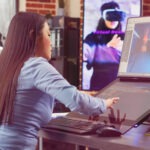How VR and AR are revolutionizing Influencer Marketing
- Jan 08, 2020
Interacting with influencers from the digital realm rather than the real-world, may sound like a sci-fi movie scenario, but in fact, this is where the influencer marketing heading with ultra-speed or is it already there? The answer is YES. Virtual and Augmented Reality is the future of influencer marketing. VR and AR are becoming mainstream media faster than you realize. As well as the fast emergence of social media, it challenges businesses to “stay up-to-date or die”. It’s no surprise that the predicted combined size of AR and VR industries is over $29.5 billion by 2020. It’s only a matter of time before every company is using some form of AR, VR, or both.
VR and AR technologies in digital marketing

There are already many companies that are using these technologies as an essential part of their digital marketing strategies in order to create a more successful brand in the market.
Coca-Cola, for example, is a company that is using Virtual Reality technology to create unique marketing campaigns in order to engage more customers and increase its market share.
But there is still much work to do behind closed doors.
Virtual reality replaces the real world while augmented reality adds to the real world. Soon, the way we hang out on social media will look and feel very different.
It’s already incorporated into mobile phones.
The first origin of the “video social world” is considered the famous multimedia messaging application Snapchat where users can add effects and filters to the multimedia posts they want to create. However, the story of these technologies was popular when people run across the streets to “catch” rare virtual creatures on Pokemon Go.
The game sparked the new wave of augmented reality explosion, but digital marketers took it beyond by enabling consumers to experience their products, like vacation destinations, beforehand.
By including augmented and virtual reality into their marketing strategies, brands can create an impulse-friendly purchasing experience for the user on any device or platform. As both technologies present unique opportunities to add a more robust customer experience which makes them must-have marketing tools to add to your marketing toolbox.
Let’s see how Coca-Cola’s incorporating VR into its digital campaign.
Coca-Cola’s Drinkable Advertising
Last year, Coca-Cola took the advertising to the next level by introducing the first-ever “Drinkable” Advertising campaign. Coca-cola collaborated with Shazam to execute the campaign. By “shazaming” the ad, users can view how Coke is pouring in the screen of their phones, filling a glass, which can be redeemed at any retail store in the US.
So, how do you “drink” in a commercial? Easy, every time you see or hear an ad on radio, TV, or billboard, even at the concert, you simply turn on the Shazam app to record the sound and enter your free drinks. As Coca Cola says, “next time your thirsty drink an ad!”
Facebook Spaces
We are done with Instagram Live and Facebook Live; it is high time to live the experience of portable technologies. Thus, the company attempted to bring the Facebook experience into social VR.
Since Facebook acquired the VR headset company Oculus Rift in 2014, the company has been developing a wide range of virtual reality experiences. Facebook spaces that launched in 2017, was one of them. The platform enabled users to build 3D avatars of themselves, paint 3D objects, make video calls and meet with friends online in virtual reality. However, it was shut down to make way to Facebook’s next social VR platform Horizon.
Snapchat – World Lenses

The third big social media company after Facebook and Twitter, Snapchat calls itself a “camera company”, and wants to be realized that its business takes advantage of the central role of the camera on smartphones.
Snapchat has already gotten in the augmented reality world by adding 3D objects that you can view through your phone’s camera while walking. The app enables adding augmented reality elements to any scene you capture with your cameras such as 3D effects, characters, and transformations to your snaps.
Snapchat Spectacles
The company also provides users to Snapchat-released the “Spectacles”, where it allows users to take photos and share snaps to the application. Spectacles are sunglasses that feature a recording camera action with one touch that shoots circular video alike to a person’s field of view.
The Spectacles were first released via bright yellow vending machines called “Snapbots”. And in the early days, it was successful, and brands started jumping on the Spectacles wagon immediately.
Currently, Spectacles don’t have any AR or VR features, but it’s exploring the possibilities of producing products like watches, visors, glasses, and other network-enabled gadgets.
How will AR and VR change influencer marketing?

These two technologies used to be more like a part of experiential marketing, now it’s a new game in its digital companion.
Although technology is developing fast, VR and AR technologies are relatively new to the influencer marketing realm. Yet marketers will surely become hand in glove with this new form of communication. It’s expected to become part of the larger bandwagon that drives influencer marketing.
VR is going to revolutionize influencer marketing by driving influencer content in a completely new direction with live-streaming VR and AR sessions.
Influencers are able to share their 360-degree live videos as a shared experience and the people just wearing VR headsets will be able to walk with them and actually talk to them as a shared experience inside a platform. This is more engaging than influencer content has ever been.
Every marketing or advertising playbook states that an experience that creates an emotional response in the user or consumer is more likely to result in purchasing. In a world that it gets the ever challenging to get consumers’ attention, utilizing VR and AR provides the abovementioned emotional experience to attract and retain consumers.
Through virtual reality technologies, consumers can lively visualize what the product will look like in their home or on their person before proceeding to check out. And they find it really appealing.
Eventually, VR promises a more trust-based relationship between influencers and customers. So, companies that adopted these technologies that merge the physical world to the digital one covered big step in a competitive industry.
There are many AR and VR influencers out there who already nailed it. Let’s get to know some of them.
Amber Osborne
Amber Oborne is a CMO at a VR meeting and education software, Doghead Simulations. She is actively involved in thought leadership within the virtual reality and tech industries, speaking at the event and writing on niche topics such as virtual reality in education.
Michael Bodekaer
Michael is an entrepreneur and innovator in the VR industry who built a virtual lab that gives students a realistic lab experience to let them perform experiments in a fun and risk-free learning environment. His TED Talk is worth checking.
Danny Bittman
Danny Bittman is another VR artist, also filmmaker, music composer, and VR creative director who develops tools like Google Tilt Brush. His VR art is centered around seizing and controlling dreams.
To sum up,
It doesn’t matter if we are communicating online or in person, face-to-face communication is always at the top of our preference. As technology continuously develops, all the barriers will eventually be taken down. Influencers will have a more personal role to play by creating real-time content that consumers can reach out to and touch.
And that is the next big step in the influencer marketing revolution. The companies that are currently exploring to leverage of technology to provide tangible value to their consumers’ lives have taken this big step.
Popular Posts
-
 Future-Proofing Talent: Skills Digital Agencies Will Need Tomorrow25 Apr 2024
Future-Proofing Talent: Skills Digital Agencies Will Need Tomorrow25 Apr 2024 -
 The Future of Leadership in Digital Agencies – Adapting to Changing Dynamics19 Apr 2024
The Future of Leadership in Digital Agencies – Adapting to Changing Dynamics19 Apr 2024 -
 Navigating UAE's Digital Frontier: A Pro's Guide to Success18 Apr 2024
Navigating UAE's Digital Frontier: A Pro's Guide to Success18 Apr 2024 -
 Eid Influencer Collaboration Dos and Don'ts: Maximizing Impact and Authenticity04 Apr 2024
Eid Influencer Collaboration Dos and Don'ts: Maximizing Impact and Authenticity04 Apr 2024






